Using the CS First Platform for scientific communication.
Federico Di Giacomo is an astronomer who works at the National Institute for Astrophysics (INAF) on public engagement and promoting historical-scientific heritage. He is currently involved in the creation of a series of digital multimedia products for the Cherenkov Telescope Array Observatory (CTAO), an international project that aims to create the largest ground-based astronomical observatory for gamma rays. In the conversation with Onelia Onorati, Federico tells us about “his” CS First Platform.
"I have always worked on the development of digital resources, both for educational and non-educational use. The so-called Fifth Industrial Revolution, which will bring technology to work side by side with human beings (think of super technological robots capable of adapting to their environments and artificial intelligence) through a synergic collaboration between cognitive abilities and the Internet of Things, will affect unthinkable areas such as the museum sector.”
“In recent years, in particular, I have worked on developing activities and courses based on coding and educational robotics that allow abstract concepts, far removed from the daily experience of children and young people, to be made concrete and manipulable, consequently increasing learning opportunities. Papert himself, a pioneer of artificial intelligence, considered robotic technology as "objects to think with." In this perspective, technology and the various coding and robotics activities, but not only, allow the development of computational thinking and all the skills that are specific to scientific research in the field of STEM.”
And then, the meeting with FMD: “Following this approach and also thanks to the support of the Fondazione Mondo Digitale, I have been using the CS First platform for several years now. I have created a series of courses and activities mainly related to physics and astrophysics, with the main objective of introducing students to astronomical science and developing computational thinking. These educational courses not only make the complex concepts of physics and astrophysics more accessible, but also stimulate students' curiosity and interest in STEM through practical and engaging learning.”
Federico started working with CS First in 2021. “At first, I was attracted by the possibility and curiosity of developing a series of innovative educational courses and activities combining astronomical concepts, such as the planets of the Solar System or the classification of stars, with an introduction to programming and computational thinking in an accessible and engaging way. The choice was motivated by the desire to provide students with innovative tools to stimulate their creativity and digital skills. Thanks to CS First, I was able to create courses and activities that combine astrophysics with programming, allowing students to explore complex scientific phenomena through coding. These courses not only make difficult concepts more accessible, but they also promoted problem solving and critical thinking, essential elements for STEM subjects. From when I started to today, I have observed many benefits in integrating this platform into school curricula. Students show greater involvement and interest in scientific subjects and develop key skills for their academic and professional future. Moreover, the integration of Scratch in CS First has transformed many of my activities into dynamic and interactive learning experiences, significantly increasing student participation and understanding.”
For Federico, “the CS First platform is a versatile and user-friendly educational resource, designed to teach programming to students with Scratch in a dynamic and fun way. Among its main features, it is integrated with Scratch, a programming platform developed at MIT, which makes coding accessible to anyone: from elementary school children to high school students. The “drag and drop” interface allows students to create complex programmes by simply moving and connecting blocks of code, making the learning process very immediate.
And there is a wide variety of topics and projects, such as animation, music, art, and storytelling, which make learning fun and stimulating. Each module is designed to capture the interest of students and encourage them to explore different aspects of programming in a creative and engaging way.
In my opinion, one of the strengths of this platform is collaboration between students, which encourages them to work together on group projects, share ideas, and solve problems collectively. This collaborative approach not only strengthens technical skills, but also develops social and communicational skills that are fundamental, especially for scientific subjects. Thanks to these characteristics, CS First is a powerful and effective tool for computer science education, capable of stimulating students' interest and preparing them for the challenges of the contemporary digital world.”
The added value for teaching is evident, both from the teaching and learning point of view. “In particular, thanks to this platform, teachers can benefit from various advantages:
- Simple implementation: Ready-to-use materials and video tutorials make it easy for teachers to integrate CS First into their lessons. The platform is designed to be intuitive, significantly reducing the time required for lesson preparation.
- Didactic support: Step-by-step guides help teachers with the lessons, even if they don’t have a background in computer science. The teaching materials provide a clear and understandable structure, allowing teachers to conduct activities with confidence and competence.
- Flexibility: the platform can be adapted to different subjects and skill levels, making it versatile for various educational contexts. Whether it is science, math, art, or language, CS First provides content that can be easily integrated and customized to meet the specific needs of each class.
CS First provides students with:
- Active learning: students learn by doing through practical projects that stimulate creativity and problem solving.
- Engagement: the interesting projects keep students motivated and interested.
- Development of digital skills: promoting critical thinking, problem resolution, and essential technical skills for the future.”
Furthermore, CS First can be defined an inclusive platform, usable by everyone regardless of cultural differences. “First of all, its accessibility is guaranteed by the fact that it is a web application available to anyone with an internet connection. This eliminates many economic and technological barriers, allowing a wide range of students to use its content.
Another key aspect is its adaptability. The projects provided by CS First can be modified to meet the needs of different skill levels and learning styles, ensuring that students can advance at their own pace and according to their abilities. This makes CS First a flexible and useful tool for a wide variety of educational contexts.
From a cultural perspective, the content is designed to be universal, without barriers. This means that it can easily be translated or adapted to meet the needs of different linguistic and religious communities, ensuring that no student is excluded. In the various projects and courses I have created, I have always tried to include both a cultural and interdisciplinary component to make learning more meaningful and contextualized. By integrating elements of history, art, and scientific tradition, I wanted to provide students with a broader and more integrated perspective of knowledge, connecting programming and computational thinking to the cultural and historical contexts that surround them. This approach not only enriches the educational experience, but also stimulates students' interest and curiosity towards different disciplines, making the learning process more engaging and relevant.
Finally, in my opinion, CS First plays an important role in combating digital illiteracy. In fact, the platform helps bridge the digital divide by promoting greater literacy amongst Italian students. This is particularly important in an era in which digital skills are fundamental to a person's academic and professional success.”
Federico is quick to describe the impact of the platform: “Student engagement is remarkable. Students are generally very engaged and motivated thanks to the hands-on and creative approach of the platform, which encourages them to explore and experiment with programming.
Another significant aspect is the simplicity of the platform. Even students with less technological experience find CS First accessible and easy to use. This makes the platform inclusive and suitable for a wide range of skills, allowing everyone to actively participate in coding lessons. In addition, CS First promotes the development of soft and technical skills, and students also develop collaboration, communication, and critical thinking skills.
Feedback from teachers involved in the various courses has also been extremely positive. They appreciate the structure of the lessons and the number of resources available, which make teaching coding less intimidating and more manageable. The detailed guides and support materials provided by CS First allow teachers to hold lessons with confidence, even if they do not have a profound knowledge of programming.
CS First is a significant added value for education. The platform promotes inclusivity and fights digital illiteracy through an innovative and accessible approach to programming.”




